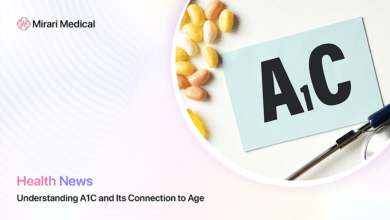Can You Develop Type 1 Diabetes as an Adult?

You may be interested
When most people think of Type 1 diabetes, they often associate it with a diagnosis in childhood or adolescence. However, while less common, it is possible for adults to develop this chronic autoimmune condition as well. In this comprehensive guide, we’ll explore the typical onset of Type 1 diabetes, the scenario of adult diagnosis, and the importance of proper management regardless of age.
Unveiling the Typical Onset of Type 1 Diabetes
Childhood and Adolescence: The Primary Age Range
Type 1 diabetes, also known as insulin-dependent diabetes mellitus (IDDM) or juvenile diabetes, is most commonly diagnosed in children and adolescents. In this autoimmune disease, the body’s immune system mistakenly attacks and destroys the insulin-producing beta cells in the pancreas. Insulin is a crucial hormone that helps regulate blood sugar levels by allowing cells to absorb glucose from the bloodstream.
The exact cause of Type 1 diabetes is not fully understood, but a combination of genetic and environmental factors is believed to play a role. Symptoms often develop quickly and can include:
- Increased thirst
- Frequent urination
- Unexplained weight loss
- Fatigue
- Blurred vision
A diabetes diagnosis in childhood or adolescence can be overwhelming, but with proper management and support, individuals can lead healthy, active lives.
A Less Common Scenario: Type 1 Diabetes Diagnosed in Adults
While the majority of Type 1 diabetes cases are diagnosed in youth, a small percentage of individuals develop the condition in adulthood. This form of Type 1 diabetes is known as latent autoimmune diabetes in adults (LADA).
Introducing LADA (Latent Autoimmune Diabetes in Adults)
LADA is a slowly progressive form of autoimmune diabetes that occurs in adults, typically over the age of 30. It is often misdiagnosed as Type 2 diabetes initially due to its slower onset and similarities in symptoms.
Understanding the Slower Progression and Atypical Symptoms
Unlike the rapid onset of Type 1 diabetes in children, LADA develops more gradually. Adults with LADA may experience milder symptoms, such as:
- Gradual weight gain
- Slightly increased thirst and urination
- Fatigue
- Blurred vision
These atypical symptoms can make it challenging for both individuals and healthcare providers to recognize LADA as Type 1 diabetes.
What are Atypical Symptoms of Type 1 Diabetes in Adults?
Atypical symptoms of Type 1 diabetes in adults can include:
- Gradual weight gain: Unlike the rapid weight loss often seen in children with Type 1 diabetes, adults with LADA may experience a slow, progressive increase in weight.
- Milder thirst and urination increases: While increased thirst (polydipsia) and frequent urination (polyuria) are classic symptoms of diabetes, adults with LADA may experience these symptoms to a lesser degree compared to children with Type 1 diabetes.
It’s essential for adults experiencing any symptoms of diabetes to consult a healthcare professional for accurate diagnosis and appropriate treatment.
The Importance of Early Diagnosis Regardless of Age
Regardless of the age at onset, early diagnosis of Type 1 diabetes is crucial for preventing complications and ensuring proper management.
Potential Complications of Untreated Diabetes
Untreated or poorly managed diabetes can lead to serious health complications, including:
- Cardiovascular disease
- Kidney damage (nephropathy)
- Nerve damage (neuropathy)
- Eye damage (retinopathy)
- Foot problems, including infections and ulcers
These complications can significantly impact an individual’s quality of life and even be life-threatening.
Consulting a Doctor for Accurate Diagnosis
If you experience any symptoms of diabetes, it’s crucial to consult a healthcare professional promptly. Your doctor will conduct a thorough evaluation, which may include:
- A review of your medical history and symptoms
- Physical examination
- Blood sugar tests, such as fasting blood sugar, random blood sugar, or A1C test
- Urine tests to check for ketones
An accurate diagnosis is essential for determining the appropriate treatment plan and management strategies.
Distinguishing Between Type 1 and Type 2 Diabetes
While both Type 1 and Type 2 diabetes involve issues with blood sugar control, they have distinct differences in their causes and management.
Key Differences in Cause and Onset
- Type 1 diabetes: An autoimmune condition where the body attacks insulin-producing cells, leading to little or no insulin production. Onset is usually rapid and occurs primarily in children and adolescents, with some cases diagnosed in adults (LADA).
- Type 2 diabetes: A metabolic disorder characterized by insulin resistance, where the body’s cells don’t respond effectively to insulin. Onset is usually gradual and occurs primarily in adults, with some cases diagnosed in children and adolescents.
When Might Someone Mistake Type 1 for Type 2 Diabetes?
Misdiagnosis of Type 1 diabetes as Type 2 can occur in adults due to several factors:
- Age at onset: Since Type 2 diabetes is more common in adults, healthcare providers might initially assume an adult with diabetes symptoms has Type 2.
- Slower progression of symptoms: Adults with LADA may experience a more gradual onset of symptoms, similar to Type 2 diabetes.
- Presence of risk factors: Obesity, family history, and other risk factors typically associated with Type 2 diabetes can lead to misdiagnosis.
Accurate diagnosis is crucial for ensuring appropriate treatment and management.
Living Well with Type 1 Diabetes: Management Strategies
Effective management of Type 1 diabetes involves a combination of insulin therapy, blood sugar monitoring, and lifestyle modifications.
The Essential Role of Insulin Therapy
Since individuals with Type 1 diabetes produce little to no insulin, insulin therapy is essential for managing blood sugar levels. This involves:
- Taking insulin injections or using an insulin pump
- Matching insulin doses to carbohydrate intake, physical activity, and blood sugar levels
- Adjusting insulin doses based on factors such as illness, stress, and changes in routine
Working closely with a healthcare team can help individuals determine the most appropriate insulin regimen for their needs.
Blood Sugar Monitoring: A Crucial Tool
Regular blood sugar monitoring is crucial for individuals with Type 1 diabetes to:
- Assess the effectiveness of their insulin therapy
- Identify patterns and trends in blood sugar levels
- Make informed decisions about insulin doses, meal planning, and physical activity
Tools for blood sugar monitoring include:
- Blood glucose meters
- Continuous glucose monitoring (CGM) systems
- Log books or digital apps to track blood sugar levels, insulin doses, and other relevant information
Consistent monitoring empowers individuals to take an active role in their diabetes management.
Healthy Lifestyle Habits: Diet, Exercise, and Weight Management
In addition to insulin therapy and blood sugar monitoring, adopting healthy lifestyle habits is essential for managing Type 1 diabetes and reducing the risk of complications.
- Diet: Focusing on nutrient-dense, low glycemic index foods and matching insulin doses to carbohydrate intake.
- Exercise: Engaging in regular physical activity to improve insulin sensitivity, manage weight, and promote overall health.
- Weight management: Maintaining a healthy weight through balanced nutrition and regular exercise.
Collaborating with a registered dietitian and a diabetes educator can help individuals develop personalized strategies for incorporating healthy lifestyle habits into their diabetes management plan.
Additional Support Systems for Effective Management
Effective Type 1 diabetes management extends beyond individual efforts and includes ongoing support from healthcare professionals and the diabetes community.
Regular Doctor Visits and Treatment Adjustments
Regular check-ups with a healthcare team, including an endocrinologist, primary care physician, and diabetes educator, are essential for:
- Monitoring overall health and screening for potential complications
- Adjusting insulin therapy and management strategies as needed
- Addressing any concerns or questions related to diabetes management
Open communication and collaboration with healthcare professionals can help individuals optimize their diabetes care plan.
Continuous Glucose Monitoring (CGM) for Real-Time Data
CGM systems provide real-time, continuous data on blood sugar levels, offering several benefits:
- Identifying trends and patterns in blood sugar fluctuations
- Alerting individuals to high or low blood sugar levels
- Providing insights for making informed decisions about insulin doses and lifestyle adjustments
CGM can be a valuable tool for fine-tuning diabetes management and reducing the risk of complications.
Support Groups: Finding Emotional Support and Information Sharing
Connecting with others living with Type 1 diabetes can provide valuable emotional support and practical insights. Support groups, both in-person and online, offer valuable opportunities for:
- Sharing experiences and coping strategies
- Learning about new management techniques and technologies
- Advocating for increased awareness and support for the Type 1 diabetes community
Engaging with local or online diabetes communities can help individuals feel less alone in their journey and provide a platform for ongoing learning and growth.
The Future of Type 1 Diabetes Care: New Advancements
As research into Type 1 diabetes continues, new advancements offer hope for improved diagnosis, treatment, and management.
Research into LADA and Improved Diagnostic Techniques
Ongoing studies aim to better understand the causes and progression of LADA, which may lead to:
- Earlier detection and diagnosis
- Personalized treatment approaches based on individual characteristics
- Improved distinction between Type 1 and Type 2 diabetes in adults
Advancements in diagnostic tools, such as more sensitive autoantibody tests, could help identify LADA cases more accurately and efficiently.
FAQs on Type 1 Diabetes in Adults
What are the Long-Term Complications of Type 1 Diabetes?
Long-term complications of poorly managed Type 1 diabetes can include:
- Cardiovascular disease
- Kidney damage (nephropathy)
- Nerve damage (neuropathy)
- Eye damage (retinopathy)
- Foot problems, including infections and ulcers
Regular check-ups, screening for complications, and maintaining good blood sugar control can help reduce the risk of these complications.
Are There Risk Factors for Developing Type 1 Diabetes as an Adult?
While the exact cause of LADA is still under research, some potential risk factors include:
- Family history of Type 1 diabetes or other autoimmune disorders
- Presence of certain genes associated with Type 1 diabetes
- Environmental triggers, such as viral infections
However, many adults with LADA have no known risk factors, emphasizing the importance of awareness and prompt diagnosis.
How Often Should I Check My Blood Sugar if I Have Type 1 Diabetes?
The frequency of blood sugar checks depends on individual factors, such as:
- Type of insulin therapy (injections vs. pump)
- Presence of CGM
- Daily activities and lifestyle
In general, individuals with Type 1 diabetes may check their blood sugar:
- Before meals and snacks
- Before and after physical activity
- Before bedtime
- More frequently during illness or stress
Consulting with a healthcare team can help determine an appropriate monitoring schedule.
Is There a Difference in Diet Between Type 1 and Type 2 Diabetes?
While both types of diabetes benefit from a balanced, nutrient-dense diet, there are some key differences:
- Type 1 diabetes requires matching insulin doses to carbohydrate intake, while Type 2 diabetes may focus more on overall carbohydrate reduction.
- Individuals with Type 1 diabetes may need to adjust insulin doses for high-fat or high-protein meals, as these can impact blood sugar levels.
Working with a registered dietitian specializing in diabetes can help create a personalized meal plan that meets individual needs and preferences.
What Should I Do if I Think I Might Have Type 1 Diabetes?
If you experience any symptoms of diabetes, such as increased thirst, frequent urination, unexplained weight loss, or fatigue, it’s crucial to consult a healthcare professional promptly. They can:
- Review your medical history and symptoms
- Conduct a physical examination
- Order appropriate blood tests to check for diabetes
- Determine the type of diabetes and develop a treatment plan
Early diagnosis and intervention are essential for preventing complications and ensuring the best possible outcomes.
Key Takeaways
- Type 1 diabetes can develop in adults, although it is less common than in children and adolescents.
- Latent Autoimmune Diabetes in Adults (LADA) is a slowly progressive form of Type 1 diabetes that can be misdiagnosed as Type 2 diabetes.
- Early diagnosis and proper management, including insulin therapy, blood sugar monitoring, and lifestyle modifications, are crucial for preventing complications and promoting well-being.
- Regular check-ups, advanced monitoring tools like CGM, and support from healthcare professionals and the diabetes community can help individuals effectively manage Type 1 diabetes.
- Ongoing research offers hope for improved diagnostic techniques and personalized treatment approaches for adults with Type 1 diabetes.
Remember, if you suspect you may have Type 1 diabetes, consult a healthcare professional promptly for accurate diagnosis and appropriate care. With proper management and support, individuals with Type 1 diabetes can lead full, healthy lives.
Your trusted source for health info, offering expert advice, news, and tips to stay healthy and informed.





